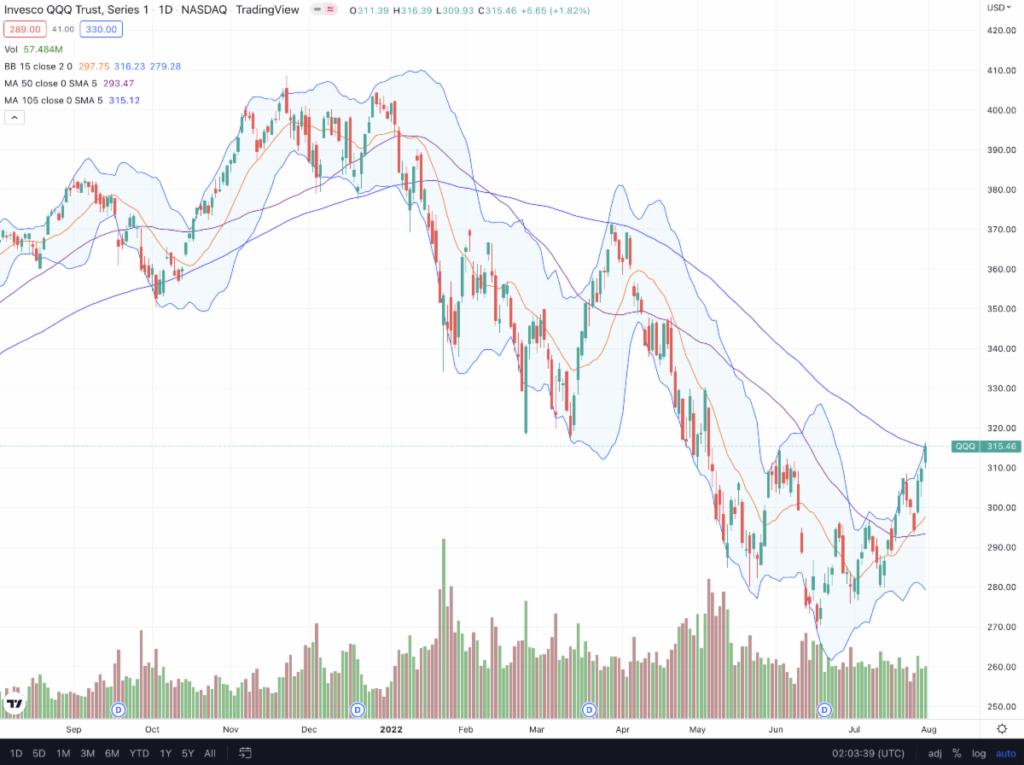 Current Market Conditions
Current Market Conditions
As expected, economic conditions in the United States and throughout most of the world have gone from bad to worse.
Earlier in July, the consumer price index (CPI) for June was released, revealing a 9.1% year-over-year increase. This inflation metric was at a 40 year high!
Last week, official gross domestic product (GDP) numbers for the second quarter (2Q) of 2022 were released: -0.9%. This was the second consecutive quarter of negative economic growth for the US.
On Wednesday, the Federal Reserve raised the federal funds rate by another 0.75%, bringing the current range to 2.25%-2.50%. Rates are normally raised in smaller, 0.25% increments, so the second consecutive 0.75% raise was unprecedented.
Not to be outdone, consumer confidence is at all-time lows. The majority of corporate CEOs think we are in or on the cusp of a recession. Approximately 45% of US small businesses have already initiated hiring freezes, and a growing minority of companies are starting to lay off workers.
Most US stocks had their worst first half of a year in over 50 years… and technology stocks had their worst first half ever. Real estate, for its part, has started to rollover from all-time highs as 30-year fixed mortgage rates have nearly doubled from just under 3% to under 6%. Much higher mortgage rates mean that housing un-affordability has also risen quickly.
In light of these (and many more) bearish conditions, Vailshire portfolios maintained their highly defensive and aggressively hedged positions throughout the month of July.
Strategies for Vailshire’s Separately Managed Accounts
While June was a solid month for us, our aggressively hedged portfolios took a beating in July.
While I still remain bearish on the economic outlook, generally, and about risk assets (like stocks and bitcoin), specifically, sometimes the market moves counter-intuitively during such times.
For instance, a typical recessionary bear market lasts approximately one year and the S&P 500 declines approximately -40%. During these long, painful declines, we frequently see counter-trend rallies. That is, even though the major trend is down, stocks often have intermittent rebounds that average +15%!
I mention these statistics so that you may know what to expect within our portfolios during these tumultuous, recessionary times. Even though we are positioned “correctly” for this bear market in risk assets–which began near the end of 2021–we sometimes fall victim to the occasional counter-trend rally.
Case in point:
From the mid-June low to the end of July, the S&P 500 has rallied (ie, a “counter-trend rally”) +14% (see the chart above). Based on the above-mention statistics, this is perfectly in line with historical recessionary bear markets. Technology stocks and bitcoin performed even better than the S&P 500, gaining +17% and +35% from mid-June, respectively.
Since we have been positioned for the larger recessionary bear market since June, our portfolios obviously performed poorly throughout the month of July.
Even with its impressive recent surge, bitcoin remains in strong bear market formation. For the accounts that are able to hedge to the downside using the new bitcoin futures ETF ($BITI), we will remain hedged until the bitcoin bear market has ended. Following this, I will enthusiastically position Vailshire portfolios for an expected, unprecedented bull market rally over the coming quarters and years.
The surge in NASDAQ stocks was strong enough to trigger our trailing stops for our technology hedge ($SQQQ). I have already started to sell out of this position within our portfolios and, if the strong price action of the NASDAQ index continues, I will immediately switch our portfolios into a bullish NASDAQ ETF.
Given the trading and investing limitations of our Conservative accounts, I am not able to actively hedge these portfolios. Therefore, these accounts are predominately in cash, with a concurrent small position in energy-related equities.
Depending on your financial objectives and individual account investment privileges, Vailshire’s Aggressive and Moderate separately managed accounts (SMAs) are currently allocated in the following manner (% base positions):
- 15-17.5% double SHORT NASDAQ ETF
- 3-4% SHORT bitcoin futures ETF
- 78.5-82% cash
Vailshire’s Conservative SMAs have limited trading privileges and are currently allocated in the following manner (% base positions):
- 10% long energy stocks
- 90% cash
If you are a Vailshire Client, feel free to log into your Vailshire-managed account(s) at Interactive Brokers and see how your own portfolios are positioned. (It’s a good idea to log into your accounts at least quarterly, just to make sure your settings and demographics are up to date.)
**Important note: For those “Conservative” clients who wish to be more aggressively hedged against anticipated declines in the equities markets, you will need to log into your Vailshire account(s) at Interactive Brokers and apply for trading privileges in “leveraged or complex exchange traded products.” If you need help with this, please let me know and I will re-send instructions from Interactive Brokers to your email. Also, if you decide to move forward with this account change, please let me know so I can begin hedging your account on your behalf.
Vailshire in the News!
On July 28, 2022, I joined Jordan Wirsz on The Savant Report for an interview, entitled “Macro Update with Dr. Jeff Ross.” Here’s a link.
Also released on July 28, 2022, was a wide-ranging interview with Natalie Brunell on her Coin Stories podcast, called “Dr. Jeff Ross on his Bearish Macro Outlook, Bitcoin and How Fiat Destroyed Health Care.”
I hope you enjoy watching these shows. If you do, please let me know your thoughts!
Conclusion
While risk assets remain in a recessionary bear market until proven otherwise, our defensive strategies took a hit during the July counter-trend rally.
Thankfully, Vailshire’s systematic investment process rolls with the punches and uses trailing stops, momentum, and asset volatility to limit additional losses and maximize future gains.
While recessions and high consumer price inflation are difficult to endure, our portfolios will continue to adapt to the underlying economic conditions and market changes to maximize upside gains whenever possible.
I am thankful for you and the trust you have placed in me to capture the best long-term gains possible throughout this tumultuous decade and beyond. If you have any questions or comments, please let me know.

